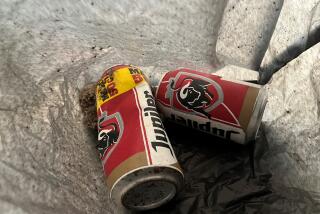At Paris Exhibit, L.A. Art Is a Smash -- Literally
The world-renowned Pompidou Center of Paris, which set out in March to celebrate the work of Los Angeles artists, has accidentally destroyed two of their works -- which fell from museum walls. A third piece was slightly damaged.
The incidents, all of which occurred during the March-to-July run of “Los Angeles 1955-1985,” have experts wondering whether a major museum has ever done so much damage in the course of a single show.
The artists involved and the Los Angeles County Museum of Art, which owned one of the destroyed works, expressed bewilderment and a deep sense of loss.
“It’s tragic,” said Lyn Kienholz, head of the California / International Arts Foundation, who acted as a go-between for the French contemporary art museum. “It never should have happened. There’s no excuse.”
“It’s not our guilt,” Catherine Grenier, who curated the show for the Pompidou, said from her Paris home. “For me, it’s not a coincidence. These two works were made of the same materials, and made in the same period. And both were incredibly fragile.”
But LACMA curator Lynn Zelevansky, who heads the contemporary art department, noted that the piece the museum lent had gone on and off display often -- and survived several earthquakes -- during its three decades in LACMA’s care.
That piece was Craig Kauffman’s “Untitled Wall Relief,” a 1967 work of acrylic lacquer on vacuum-formed Plexiglas that measured 52 by 78 inches. Pompidou officials told LACMA it fell and shattered July 16, just before the show closed.
“It’s extremely upsetting,” said LACMA Director Michael Govan. “We’re still investigating all of the details.”
The other total loss was an untitled piece made by Peter Alexander in 1971 and lent by the Franklin Parrasch Gallery in New York. That resin work, which resembled a black bar about 8 feet high and 5 inches wide, fell overnight in the days before the show opened to the public in March.
“I’d been sort of holding on to it preciously,” Alexander said from his Santa Monica studio. “I don’t know whether it’s arrogance or passivity, but I’ve never dealt with anybody or any institution that works this way.”
Alexander said that the museum notified his gallery, paid $28,000 in compensation and borrowed another piece to fill the gap in the show, but that nobody at the Pompidou contacted him directly.
At LACMA, Govan said he got a July 21 e-mail from the Pompidou’s director, Alfred Pacquement, who reported that Kauffman’s work “suddenly fell from the wall,” and offered “deepest regrets.” LACMA passed the news to the artist, who lives in Angeles City, the Philippines.
“Maybe I should have looked more closely,” said Kauffman, who journeyed to Paris to see the show. “I just assume everybody knows what they’re doing. And I guess they don’t.”
Although the piece’s value was estimated at a relatively modest $70,000 last year, Zelevansky called the Kauffman piece “a stalwart of the collection. It’s a terribly important piece, for the artist, the institution and the community. It’s a major loss for us.... Whatever the market wants to say about it, in terms of the history of Los Angeles art, this is crucial material, and this was a very important piece.”
LACMA and the Pompidou’s insurers are negotiating compensation.
In March, the Pompidou also slightly damaged and repaired a third piece from the show, a Robert Irwin work on loan from the foundation of Los Angeles philanthropist Eli Broad. After the incident, a Broad Art Foundation spokeswoman said, “We requested that the painting be moved to a location we thought would be safer for the work, and our registrar personally oversaw the movement of the painting to its new location.”
The Paris exhibition featured more than 300 works by more than 80 artists, among them John Baldessari, Billy Al Bengston, Dennis Hopper, Eleanor Antin, Lari Pittman, Charles Ray, Chris Burden, Nancy Rubins, Judy Chicago, John Divola, Robert Heinecken, Ed Moses and Betye Saar. To pull it together, the Pompidou borrowed more than a dozen works from LACMA. Grenier said 300,000 visitors saw the show.
Museum curators accept loan troubles as a cost of doing business, including the occasional minor damage, or less frequent losses and thefts. But Alexander, Kauffman, Grenier, Govan, Zelevansky and Kienholz could not recall any show in which two works of art were destroyed by accident in separate incidents.
Though both of the shattered works were made of modern materials whose long-term endurance has not been demonstrated -- one Plexiglas, one molded polyester resin -- some art experts said the dual destruction had them wondering whether this was unprecedented bad luck or a problem with museum procedures.
At the Broad Art Foundation, which has lent works to more than 400 museums worldwide over the last 20 years, director and chief curator Joanne Heyler said, “We would expect that the Pompidou is engaging in a serious review of its procedures and safeguards and are saddened that such a successful project is marred by these incidents.”
Grenier, the French curator, said: “We are waiting for the report to tell exactly what was wrong. But it’s not something with the installation, not something with the public.”
Govan said he was “very curious” to learn more about the accidents, especially because LACMA had sent its own specialist to Paris to oversee the installation of the Kauffman piece. But in the meantime, he said, it would be rash to make any changes in lending practices.
“It’s like a plane crash,” said Govan. “Would you never fly on an airplane? It’s still a relatively safe business.”
More to Read
The biggest entertainment stories
Get our big stories about Hollywood, film, television, music, arts, culture and more right in your inbox as soon as they publish.
You may occasionally receive promotional content from the Los Angeles Times.











